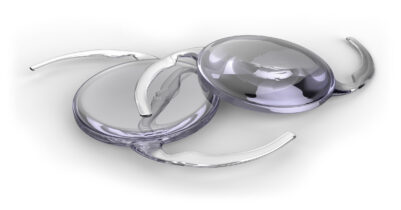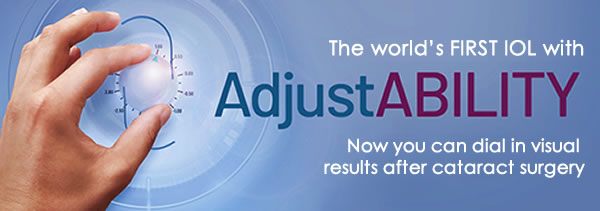
During cataract surgery, your cataract is removed and a new clear lens is placed. You and your surgeon will decide which type of intraocular lens (IOL) is best for you. There are many intraocular lenses available on the market. Each lens will have it’s own benefits and drawbacks. The key to key to matching each patient to the best lens for their lifestyle and situation is a both an art and a science.
A monofocal IOL is the basic lens which is covered by insurance. It is important to know that this type of lens provides focus at only one single distance. Most patients with a monofocal IOLs choose to have their vision corrected for distance and rely on glasses to meet their intermediate and near vision needs. You can see the illustration to the left which simulates monofocal vision in which distance is clear, but both near and intermediate vision are blurry. (This simulation demonstrates the vision of someone with little to no astigmatism, see below for the discussion on astigmatism). Patients with monofocal lenses after cataract surgery may prefer to wear bifocal, trifocals, or progressive glasses throughout the day after their cataract surgery. Others may choose to keep readers around the house to take on and off depending on their task at hand. Quality prescription glasses can be quite costly and need to be replaced regularly, so the cost savings in choosing a monofocal IOL evens out with the need for prescription glasses.
Surgeon tip: Is it possible to choose to have good near vision and blurry distance vision? Yes! Once every so often, I will have a patient who is already nearsighted and enjoys reading without glasses and doesn’t mind distance glasses. The patient can stay nearsighted with a lens calculated for near vision clarity, but once again will need glasses for their distance and intermediate vision.
Monovision IOLs
One solution to get around the blurry near vision is to use a technique called monovision. With monovision, your surgeon can select a monofocal IOL correcting each eye to a different power. One eye is corrected to distance and the other eye is corrected for near. When both eyes are open, a patient enjoys a blended vision. Folks who do well in monovision contacts tend to enjoy monovision intraocular lenses as well.
Surgeon tip: Patients that do not have contact lens experience with monovision can find it disorienting to have a power difference between their two eyes. Some people find that monovision compromises the clarity of their distance vision too much. For this reason I only offer this option to my patients who have had prior experience in contact lenses with monovision.
Toric IOLs

Toric IOLs are a premium type of lens that helps to correct for astigmatism. Astigmatism occurs when the natural shape of the cornea, or front of the eye, is more like an American football rather than a round basketball. Often patients with astigmatism experience blurry vision at all distances. Prior to cataract surgery, the astigmatism can be corrected in glasses and in contact lenses. However, cataract surgery gives an opportune time to correct the astigmatism with a toric IOL. The additional costs for the toric IOL are not covered by insurance, but insurances allow this upgrade to be paid for out of pocket by the patient.
Patients with astigmatism often remark being dependent on their glasses at all times for all distances. In my practice, I recommend toric IOLs to patients with moderate to high astigmatism for the best optical results and to allow clear vision with more spectacle independence.
Multifocal IOLs
A multifocal IOL is the most advanced premium lens. Multifocals lenses provide vision across varying distances. These lenses minimize the need for glasses by fixing the problem of presbyopia, which is the need for near-readers with age. When choosing a lens for my mother when doing her cataract surgery in 2019, I knew that she would benefit from a multifocal lens because 1) other than having cataracts, her eyes were otherwise healthy, 2) in her youth she was used to reading without any glasses, and 3) she leads an active lifestyle and found her reliance on glasses to be an annoyance.
Johnson & Johnson’s trifocal lens is one of the leading presbyopia-correcting lenses which offers a crisp focal point at distance, intermediate computer vision, and near reading vision. Patients often comment on the sharpness of their near vision after surgery. The Odyssey can even correct astigmatism. I really like to use this lens for my patients who do a lot of computer and near reading work but also want to enjoy crisp distance vision. Compared to traditional multifocal IOLs, the Odyssey aims to minimize visual disturbances such as halos, glare, and starbursts. This makes it an attractive option for patients concerned about night vision issues often associated with multifocal lenses.
Visit www.clearvisionforyou.com/en-us/vision-simulator to learn more about the Odyssey intraocular lens.
Surgeon tip: Post-operative dry eye can be an annoying problem after cataract surgery. I like to warn patients that if they have underlying dry eye, the eyes will be even more dry for the first 3-6 months after cataract surgery. Dry eyes can cause irritation as well as glare and halo around lights. These visual disturbances can be particularly noticeable for patients with multifocal lenses initially when the dry eye is at its worst and improve as the ocular surface returns to its normal state.
Alcon’s Vivity Extended Depth of Focus lens is another leading presbyopia-correcting lens. The non-diffractive technology called X-Wave design allows for elongated focus range. As a result, this lens allows patients to see from distance to intermediate to near as one continual range of focus. The optics are so good, often patients comment on the vivid colors and the crispness of their distance vision after surgery. This lens can also correct astigmatism. I like to use this lens in patients who enjoy crisp distance vision and who like the clarify of reading their phone or labels without glasses but who don’t necessarily spend a lot of time at the computer or reading books.
Surgeon tip: For some patients with certain eye conditions like retinal issues, glaucoma, or severe dry eye syndrome, multifocal lenses may not work as effectively as they would in someone without these conditions. Most of the time, advanced testing can detect these issues before surgery. In these cases, your surgeon can guide you to a lens like an Alcon Vivity over a multifocal or trifocal lens. The goal is finding a lens that best fits your lifestyle and vision needs, ensuring you get the clearest vision possible.
Lenstec’s Clearview lens is rising in popularity as a premier presbyopia-correcting lens in 2024. Lenstec uses tighter manufacturing tolerances compared to other IOL manufacturers. For example, the ClearView IOL has a power tolerance of ±0.25 diopters, while many other IOLs have a tolerance of ±0.40 or ±0.50 diopters. Unlike a trifocal IOL designed with concentric rings or zones, allowing the lens to focus light at multiple distances, this lens has a distance and near zone and as a result prioritizes minimizing spherical aberrations and improving contrast sensitivity.
Surgeon tip: Clearview is a great lens for patients with minimal astigmatism. Ideally astigmatism less than 1 diopter can be corrected with laser based cataract surgery and be paired with the Clearview lens. There are some great Clearview testimonials on Youtube.com
Light Adjustable Lenses

The Light Adjustable Lens (LAL) from RxSight has changed the way we think about cataract surgery with its adjustability. In traditional cataract surgery, the surgeon chooses a lens prior to surgery. The lens is calculated from preoperative measurements evaluating the shape of the front of the eye and the length of the eye. Although these measurements have become quite exact with our sophisticated biometers, difficulty arises in measuring patients with corneal scars, prior corneal infections, prior LASIK or PRK surgery as well as patients with radial keratectomy. Dense cataracts can also be difficult to measure as can highly far-sighted or near-sighted eyes. Despite all this precision, another aspect that remains challenging is how the lens finally heals and settles in each individual unique eye. How the lens heals and sits affects its effective lens position and thereby its final prescription with the eye.
With the light adjustable lens your surgeon has the capability to change and customize the shape and prescription of the lens noninvasively after surgery. This allows patients to be able to test drive their vision after surgery. It also allows the surgeon to correct astigmatism and account for any far-sightedness or near-sightedness in the eye’s final healed state. Beginning at 18 days after surgery, there can be 2-5 light treatments lasting 90 seconds to reshape the lens. Each light treatment is spaced 3 days apart to allow time for further measurements and for patients to test drive their vision. Watch more about the Light Adjustable lens here.
In 2024, the LAL+ came out which is an advanced version of the original lens designed to offer a broader range of vision. It builds upon the foundation of the original LAL, which allows post-operative vision adjustments using UV light treatments, by incorporating features aimed at improving not only distance vision but also intermediate and near vision by providing extended depth of focus (EDOF), meaning it offers a broader range of clear vision at different distances—distance, intermediate, and some near.
Surgeon tip: The Light Adjustable Lens was FDA approved in 2017. Initially patients were required to wear UV protecting sunglasses and clear glasses to prevent the lens from inadvertently adjusting post operatively from stray UV light. Since its approval, RXSight has introduced ActivShield™ Technology, a special UV protection layer built into the newly updated Light Adjustable Lens. In effect, this new layer protects the lens from changing shape except during the set postoperative treatments. For additional protection, patients will also be provided with special UV-blocking glasses to wear during this period. These glasses will provide redundant protection until the last treatment is complete.
Mixing and Matching IOLs
Common IOL Combinations:
-
Monofocal + Monofocal (Monovision)
- How it works: One eye is corrected for distance vision and the other for near vision.
- Pros: Simple solution, good for patients who want to avoid glasses for most daily activities.
- Cons: Some patients may struggle with depth perception or feel uncomfortable with the difference in focal points between the eyes.
-
Monofocal + Multifocal
- How it works: A monofocal IOL is placed in one eye (usually dominant) for distance vision, and a multifocal IOL is placed in the other eye for a range of vision (near, intermediate, and distance).
- Pros: Can improve both distance and near vision, with less reliance on glasses.
- Cons: Multifocal IOLs can cause glare and halos, particularly at night, which some patients may find bothersome.
-
Monofocal + Extended Depth of Focus (EDOF)
- How it works: A monofocal IOL is placed in one eye for distance, and an EDOF IOL in the other to improve intermediate and some near vision.
- Pros: Provides smoother transition between distances, often with fewer side effects like glare compared to multifocals.
- Cons: May still require glasses for near tasks, such as reading fine print.
-
EDOF + Multifocal
- How it works: An EDOF IOL in one eye for a broader range of intermediate and distance vision, and a multifocal IOL in the other for better near vision.
- Pros: Gives patients good vision across a range of distances, reducing the need for glasses.
- Cons: Can still present challenges with night vision and glare from the multifocal IOL.The
In early 2024, when I performed cataract surgery on my father, we selected a multifocal lens for his non-dominant eye to offer him the greatest flexibility in his vision. For his dominant eye, we opted for a Light Adjustable Intraocular Lens (LAL), given its ability to be precisely customized after surgery. As a retired engineer, my father values the precision and adaptability that the LAL offers. When asked which eye he prefers, he finds it difficult to choose because, with both eyes open, his vision blends seamlessly, providing the sharpest sight he has experienced in years—without the need for glasses.
Conclusions
The topic of IOL choice during cataract surgery can be a complex confusing topic. There are almost too many good options on the table. I have found that the best way to choose a lens is get to know my patients. By understanding what activities you enjoy doing and what tasks require your attention during the day, we will best be able to match the best lens to meet your vision goals. Combined with the state-of-the-art ocular analysis, we can match your vision goals to meet your true visual potential.
This article was originally written on 6/23/2020 by Angelique Pillar, MD and updated on 09/15/2024.
